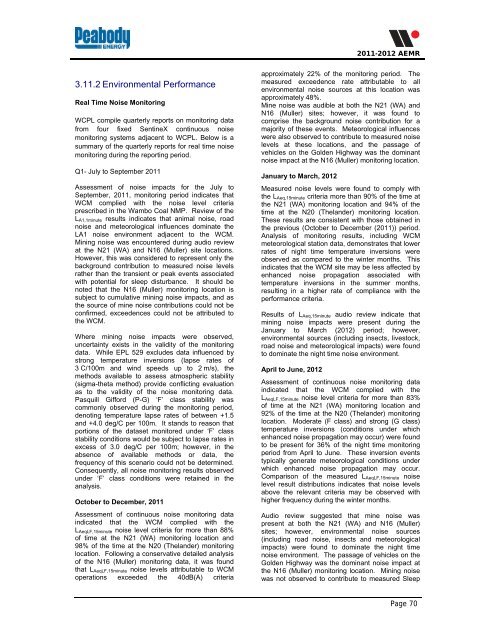Wambo Coal AEMR 2011-2012 - Peabody Energy
Wambo Coal AEMR 2011-2012 - Peabody Energy
Wambo Coal AEMR 2011-2012 - Peabody Energy
Create successful ePaper yourself
Turn your PDF publications into a flip-book with our unique Google optimized e-Paper software.
<strong>2011</strong>-<strong>2012</strong> <strong>AEMR</strong><br />
3.11.2 Environmental Performance<br />
Real Time Noise Monitoring<br />
WCPL compile quarterly reports on monitoring data<br />
from four fixed SentineX continuous noise<br />
monitoring systems adjacent to WCPL. Below is a<br />
summary of the quarterly reports for real time noise<br />
monitoring during the reporting period.<br />
Q1- July to September <strong>2011</strong><br />
Assessment of noise impacts for the July to<br />
September, <strong>2011</strong>, monitoring period indicates that<br />
WCM complied with the noise level criteria<br />
prescribed in the <strong>Wambo</strong> <strong>Coal</strong> NMP. Review of the<br />
L A1,1minute results indicates that animal noise, road<br />
noise and meteorological influences dominate the<br />
LA1 noise environment adjacent to the WCM.<br />
Mining noise was encountered during audio review<br />
at the N21 (WA) and N16 (Muller) site locations.<br />
However, this was considered to represent only the<br />
background contribution to measured noise levels<br />
rather than the transient or peak events associated<br />
with potential for sleep disturbance. It should be<br />
noted that the N16 (Muller) monitoring location is<br />
subject to cumulative mining noise impacts, and as<br />
the source of mine noise contributions could not be<br />
confirmed, exceedences could not be attributed to<br />
the WCM.<br />
Where mining noise impacts were observed,<br />
uncertainty exists in the validity of the monitoring<br />
data. While EPL 529 excludes data influenced by<br />
strong temperature inversions (lapse rates of<br />
3 C/100m and wind speeds up to 2 m/s), the<br />
methods available to assess atmospheric stability<br />
(sigma-theta method) provide conflicting evaluation<br />
as to the validity of the noise monitoring data.<br />
Pasquill Gifford (P-G) ‘F’ class stability was<br />
commonly observed during the monitoring period,<br />
denoting temperature lapse rates of between +1.5<br />
and +4.0 deg/C per 100m. It stands to reason that<br />
portions of the dataset monitored under ‘F’ class<br />
stability conditions would be subject to lapse rates in<br />
excess of 3.0 deg/C per 100m; however, in the<br />
absence of available methods or data, the<br />
frequency of this scenario could not be determined.<br />
Consequently, all noise monitoring results observed<br />
under ‘F’ class conditions were retained in the<br />
analysis.<br />
October to December, <strong>2011</strong><br />
Assessment of continuous noise monitoring data<br />
indicated that the WCM complied with the<br />
L AeqLF,15minute noise level criteria for more than 88%<br />
of time at the N21 (WA) monitoring location and<br />
98% of the time at the N20 (Thelander) monitoring<br />
location. Following a conservative detailed analysis<br />
of the N16 (Muller) monitoring data, it was found<br />
that L AeqLF,15minute noise levels attributable to WCM<br />
operations exceeded the 40dB(A) criteria<br />
approximately 22% of the monitoring period. The<br />
measured exceedence rate attributable to all<br />
environmental noise sources at this location was<br />
approximately 48%.<br />
Mine noise was audible at both the N21 (WA) and<br />
N16 (Muller) sites; however, it was found to<br />
comprise the background noise contribution for a<br />
majority of these events. Meteorological influences<br />
were also observed to contribute to measured noise<br />
levels at these locations, and the passage of<br />
vehicles on the Golden Highway was the dominant<br />
noise impact at the N16 (Muller) monitoring location.<br />
January to March, <strong>2012</strong><br />
Measured noise levels were found to comply with<br />
the L Aeq,15minute criteria more than 90% of the time at<br />
the N21 (WA) monitoring location and 94% of the<br />
time at the N20 (Thelander) monitoring location.<br />
These results are consistent with those obtained in<br />
the previous (October to December (<strong>2011</strong>)) period.<br />
Analysis of monitoring results, including WCM<br />
meteorological station data, demonstrates that lower<br />
rates of night time temperature inversions were<br />
observed as compared to the winter months. This<br />
indicates that the WCM site may be less affected by<br />
enhanced noise propagation associated with<br />
temperature inversions in the summer months,<br />
resulting in a higher rate of compliance with the<br />
performance criteria.<br />
Results of L Aeq,15minute audio review indicate that<br />
mining noise impacts were present during the<br />
January to March (<strong>2012</strong>) period; however,<br />
environmental sources (including insects, livestock,<br />
road noise and meteorological impacts) were found<br />
to dominate the night time noise environment.<br />
April to June, <strong>2012</strong><br />
Assessment of continuous noise monitoring data<br />
indicated that the WCM complied with the<br />
L AeqLF,15minute noise level criteria for more than 83%<br />
of time at the N21 (WA) monitoring location and<br />
92% of the time at the N20 (Thelander) monitoring<br />
location. Moderate (F class) and strong (G class)<br />
temperature inversions (conditions under which<br />
enhanced noise propagation may occur) were found<br />
to be present for 36% of the night time monitoring<br />
period from April to June. These inversion events<br />
typically generate meteorological conditions under<br />
which enhanced noise propagation may occur.<br />
Comparison of the measured L AeqLF,15minute noise<br />
level result distributions indicates that noise levels<br />
above the relevant criteria may be observed with<br />
higher frequency during the winter months.<br />
Audio review suggested that mine noise was<br />
present at both the N21 (WA) and N16 (Muller)<br />
sites; however, environmental noise sources<br />
(including road noise, insects and meteorological<br />
impacts) were found to dominate the night time<br />
noise environment. The passage of vehicles on the<br />
Golden Highway was the dominant noise impact at<br />
the N16 (Muller) monitoring location. Mining noise<br />
was not observed to contribute to measured Sleep<br />
Page 70

















